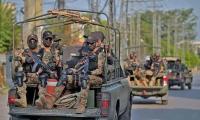NEW YORK: Urging the Security Council to look into the ongoing ethnic cleansing of Rohingya Muslims in Myanmar, the United Nations (UN) director at the Human Rights Watch said that it was not the time to walk on egg shells, adding that the Council needed to hold an open meeting to address the ordeal of Rohingyas.
“About 370,000 Rohingyas are fleeing Myanmar, and the countries in support of the oppressed community need to urge Council to hold a public meeting in order to address the situation at hand; this is ethnic cleansing on a large scale. The Security Council is supposed to be the guardian of international peace and security,” he said.
He added that the praises about de facto leader Aung San Suu Kyi were not in line with the current crisis and there was no evidence that a process to curb it was in place.
Sherine Tadros, Amnesty International’s UN representative, said that the issue wasn’t just about holding meetings because the situation was extremely grave. She said: “Let’s be clear here, this isn’t about having another meeting — whether open or close. It’s about Security Council uniting and sending a very public message to the government of Myanmar to put an end to ongoing violence.”
She added that an unfretted entry should be given to independent journalists and UN representatives. The time to hold discussions was now over, she concluded.Tirana Hassan, Amnesty international’s crisis response director, spoke at length about the plight of Rohingya Muslims. Hassan has been covering the ethnic crisis in the region from Cox’s Bazar, Bangladesh. She highlighted that the Rohingya crisis did not spring up suddenly, rather it was brewing for many years.
“It is a sea of human misery, and it is unprecedented in terms of the level of violence targeting the Rohingyas. Comparing to what I saw a week ago, I’d say it is like watching crisis unfold at speed 10. Each day, there are more horrors to document. What is particularly disturbing is how people tell that their families have been taken away by security forces, and they always end up telling how thousands are still behind them.”
She added that people were arriving via sea and due to shortage of camps they were just lying on lands. Hassan said: “Despite the claims of Myanmar government regarding counter-insurgency, it was a form of collective punishment in response to the August 25 attack on police forces, when insurgents killed a dozen security officials.”
“Discrimination against the Rohingyas is decades old, but the scale of this campaign targeting them is new. A man told me that while he hid in the jungle, all those who failed to do so, their hands were tied with a rope in a long chain and there were 10 men per rope, and they marched to a nearby village, where security forces had a base, and there are testimonies about men not knowing the whereabouts of men and boys.”
Akshaya Kumar, deputy UN director at Human Rights Watch, used satellite imagery to explain that 21 areas were set on fire, which could be spotted from satellite, and an observer reported that he saw – from the Bangladesh border – that six villages were set on fire as well.Showing an image of an area, Kumar showed how 450 buildings were destroyed and all of them belonged to Rohingyas.
“It’s been 12 days since the Security Council had held a meeting. Opening a meeting is a first step, followed by passing a resolution, which would force the military to stop the campaign [ethnic cleansing] via travel bans and sanctions,” she said.
“Helicopters and mortars are being used to attack the areas and not all crimes are being committed by machetes and knives so there is a broader possibility about the supply of arms,” she concluded.Later, it was also told that the Office of the United Nations High Commissioner for Refugees had sent aid to Cox’s Bazar
According to the CTD spokesman, the two were attempting to enter Punjab from Khyber Pakhtunkhwa
Foreign Office's silence on the US threat to impose sanctions on Pakistan for economic agreements with Iran
President Zardari express views while talking to the visiting Chairman of China International Development Cooperation...
Kundi emphasised that recent electoral outcomes indicated a public preference for parliamentary cooperation over...







